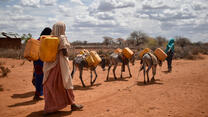
World hunger is still a problem facing the world in 2024. Get the facts about the global hunger crisis as it stands and learn what can be done.
1. One in every 11 people in the world are hungry
As many as 757 million people went hungry in 2023. That means one out of 11 people in the world had too little food for basic health.
2. Sudan is facing the world's worst hunger crisis
Sudan is facing a hunger catastrophe. Violent conflict and widespread displacement of people means that over 20 million people faced crisis levels of food shortages in 2023. This situation has not improved, and some areas are now facing famine.
3. Hunger and malnutrition are not the same thing
Hunger is the physical sensation caused by a lack of food, while malnutrition refers to nutritional deficiencies such as lack of protein or energy. However, the two things are closely related and the global hunger crisis is also a malnutrition crisis.
4. Nearly half of all child deaths are linked to malnutrition
Hunger-related health problems are the single biggest cause of deaths and almost half of child deaths are linked to undernutrition. For those children who survive, the long-term effects of malnutrition are often serious, including impacts on physical and cognitive development.
5. Malnutrition is treatable, yet fewer than 1 in 5 children get treatment
Around the world, an estimated 45 million children under the age of five experience acute malnutrition at any given time. Up to two million of these children die as a result annually.
There are proven, low-cost treatments for acute malnutrition available, but fewer than 1 in 5 children receive the treatment they need. Simpler approaches can help to improve access.
6. Globally, we have made progress towards ending hunger
Global hunger has decreased in the past 50 years. While 1 in 11 people are hungry today (9%), this was much higher in 1970, at 1 in 4 (or 24%). Progress is possible.
However, in recent years, this progress has been undermined. Violent conflicts, climate change and extreme poverty are increasingly concentrated in a small group of countries. People within these affected areas and countries are facing many challenges at once, which is leading to new hunger crises.
7. Climate change and conflict are causes of hunger
Natural hazards are increasing as global temperatures rise, and climate-related disasters such as droughts and floods are destroying farmland and leading to food insecurity. Because of climate change, global food prices are expected to rise 20% by 2050.
Conflict is another key factor behind global hunger. The “man-made food crisis” in Sudan is a result of ongoing violent conflict that is exacerbating existing problems such as skyrocketing food prices.
What can we do about hunger crises?
Address the malnutrition treatment gap
Despite solutions to malnutrition being available, fewer than 1 in 5 children access treatment. The IRC believes that simplified approaches to malnutrition can address this treatment gap. By simplifying diagnosis and treatment, assessments done by the IRC have shown a 92% recovery rate with 21% lower costs and increased accessibility. Learn more about this simpler approach.
What is the International Rescue Committee (IRC)?
The International Rescue Committee (IRC) helps people whose lives have been shattered by conflict and disaster to survive, recover and rebuild.
Founded in 1933 at the call of Albert Einstein, we now work in over 40 crisis-affected countries as well as communities throughout Europe and the Americas.



